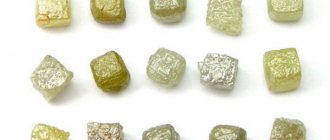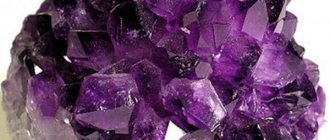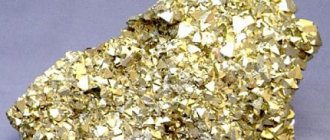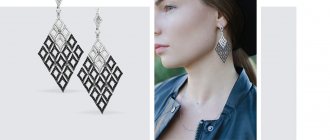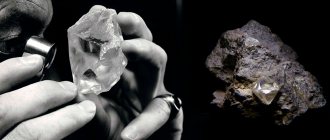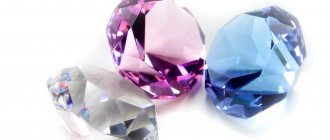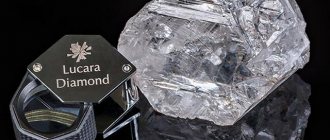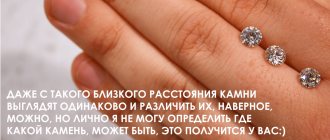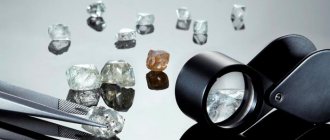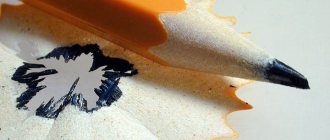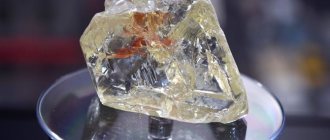Hello, dear readers and admirers of natural unique jewelry! Today we will talk about the king and leader of all stones - the diamond. What about a diamond in the rough? Is an uncut diamond valuable, what does it consist of, and how does it differ from its ideal double other than its appearance? These and other interesting facts will be discussed today.
Well, what lady would refuse a ring or earrings with a real diamond, even if it has very few carats. Even miniature specimens sometimes shine so much that their shine is visible several meters away. These are cut, perfected stones that everyone rave about and which occupy an honorable first place in the jewelry industry.
Old-timer stone: what an uncut diamond is made of
Diamond first appeared to the world many millions of years ago. Yes, yes, humanity has long found this treasure, but at first people did not pay any attention to the unsightly stone. It was harder in comparison with other minerals and that’s all. Indeed, a crystal without a cut and a certain chiseled shape could hardly cause delight and admiration. But today everyone applauds its aesthetic properties and beautiful tints.
What is a rough stone? Just carbon. A diamond contains about 99% of this substance, and 1% of impurities, which can give the stone different shades (manganese, chromium, titanium and others).
Colorless transparent stones are very rare in nature, since impurities are present in almost everyone. And the color itself is not always uniform, because nature is an abstract artist who does not recognize any rules when creating her works.
A white transparent diamond, as we are used to seeing it in photos in glossy magazines and the Internet, is the work of human hands, who work long and painstakingly on the stone so that it shines with all its facets.
By the way! The word “diamond” comes from the consonant “adamas” (Greek), which means “indestructible, powerful.” They find stones at the foot of volcanoes or in caves of volcanic rocks. After the eruption, the gems themselves come out of the depths and literally go into the hands of successful mineralogists.
A little about mining
Diamond deposits are located in Russia, South Africa, the Republic of Congo and Namibia. Australia, Canada, Angola and Botswana boast small deposits. The development of diamond deposits is a long and expensive process.
Until the second half of the 20th century, gems were mainly mined from minor deposits that appeared as a result of rock faults. Everything was done in the same way as during gold mining: river sand was sifted through a sieve and then washed. Now the crystals remain mainly in “kimberlite pipes.”
Mining is carried out in 3 stages: a 600-meter pit is punched with the help of explosives, a shaft is laid and ore begins to be mined, which is later delivered to the factory for subsequent grinding and washing. Then they cull, choosing the desired type of stone using water and x-rays. And after this, the diamonds are handed over to cutters and jewelers.
Solid but fragile
So, as we found out, diamonds in their original form were not previously of particular value to jewelers. The only thing that struck me about him was his unprecedented hardness. The Mohs scale of mineral hardness states that diamond is the hardest gem in the world. For example, it is 1.5 thousand times harder than quartz! But here’s a paradox: despite its quality, diamond is quite fragile. That is, if you throw it to the ground with all your might, it... will break.
Many centuries ago, out of ignorance, the subjects of Louis the 11th crushed into crumbs a huge collection of diamonds that belonged to Duke Charles the Bold. The misunderstanding arose from a desire to check whether the diamonds were real or fake.
Therefore, if someone whispered to you that the authenticity of a stone can be determined by hitting it with a hammer, do not try to repeat this “deadly number”!
About the characteristics
The aesthetics of a stone greatly depends on how the atoms in the crystal lattice are arranged. It has a cubic shape, with four carbon atoms located in the center and eight at the vertices of the cube. In addition to carbon, small inclusions of iron, magnesium and calcium can be found in its composition.
The stone is varied in color. Mostly, crystals without color or a yellowish tint are found or mined. Sometimes they are blue, with a red tint or blue, pink, gray, brown and black. Green diamonds are extremely rare. Crystals are also classified according to their degree of purity. Most stones have uneven coloring, sometimes one color dominates.
Diamond is a mineral of the highest hardness with a 10-point rating on the Mohs scale, compared to other stones. From Greek it is called “invulnerable”. But if you drop it, it will break. You can make it burn by using a simple magnifying glass and heating it to 700°C. For the ancient Greek rulers, this stone personified power.
There are no two identical stones in the world. Each of them has its own unique “inclusions” that make it unlike other stones. Inclusions are internal voids, foreign substances and cracks. Diamond is not afraid of strong acids, but an alkaline solution of soda or saltpeter can oxidize the gem.
The stone has luminescent properties that allow it to serve as an indicator of radioactivity. At the same time, the stone begins to emit light pulses and a weak electric current.
Rough diamonds in industry
Today, uncut diamonds are in demand not only in jewelry, where they end up after many manipulations (grinding, polishing, etc.). It is known that 85% of crystal mining goes into industrial and military production. Cutters, abrasives, and drilling devices are made from industrial diamond.
Of course, nature’s resources are not endless and the needs of industrial production and jewelry cannot be met by natural stones alone. But humanity has long found a way out: now diamonds are successfully synthesized from carbon under the influence of high temperatures and pressure. Artificial pebbles are in no way inferior to natural ones in their strength and external characteristics.
Thus, industrial diamonds have also been learned to be made without the participation of Mother Nature. Black carbonado, white board and gray ballas are their most striking representatives.
What are rough diamonds
What is taken out of the ground and not subjected to any mechanical processing is rough diamonds. What lies on the shelves of jewelry stores are processed stones, they were given the shape necessary for decoration and polished for a bright shine. After diamonds are mined, they are selected for quality.
There are examples of low quality - these diamonds are used for industrial production because they do not have any jewelry value. And there are high quality stones - they go through all stages of processing and then delight jewelry lovers.
Jewelry work and the price of the finished diamond
And how many types are synthesized for jewelry: moissanite, cubic zirconia, rhinestones and other substitutes have become a real salvation for fans of diamond diamonds and collectors of expensive jewelry. As for real diamonds, with dozens of facets and an incredible glow, they are much more expensive than substitutes. When an uncut stone reaches the stage of a perfect, elegant diamond, it sometimes loses up to 50% of its mass, but the price increases significantly due to this.
Typically, the cost of a finished stone is estimated depending on its:
- colors;
- weight;
- presence or absence of impurities;
- type of cut;
- polishing
How diamonds become diamonds
Everyone knows that a cut diamond is called a diamond. What shape it will be given depends solely on its natural characteristics. An uncut stone is dull and ugly. The work of a jeweler turns it into a sparkling, smooth and expensive diamond.
Stones intended for cutting must be of the appropriate size, since 40 to 60% of its volume will be lost during processing.
Jewelry began to work with various precious stones long ago, but they learned to cut diamonds only 600 years ago; before that, for example, rings were made with untreated natural diamonds. And even when they learned how to do this, the process remained difficult and painstaking, requiring the implementation of the various stages of processing the gem in order.
Diamond Processing Methods
There are two options: laser or manual.
When a diamond is created by hand, the following steps are taken:
- Split. Based on the marks that the specialist made during the initial examination, notches are made on the fixed diamond with another crystal. Then they are hit precisely, and the stone splits.
- Sawing Here the diamond is fixed with gypsum or limestone on a special copper head that is clamped into a sawing machine. Sawing is done with a very thin disk lubricated with abrasive paste. It consists of oil and diamond dust. The process is one millimeter per hour.
- Rounding the surface using another diamond.
- Cutting. For bevelling, the stone is fixed in the clamps of a grinding machine using a quadrant in such a way as to achieve the desired angle relative to a steel grinding disc lubricated with abrasive paste.
Since the development of technology does not stand still, the jewelry industry has also received new opportunities for processing rough diamonds. In this case, a cutting method using laser equipment is used. The stone for cutting is examined by a specialist who decides what to do with it. Then everything happens in the same way as during manual processing.
Using laser processing, you can achieve the desired shape of stones. The downside is a significant reduction in the weight of the stone compared to manual processing.
Weight is everything
But how to determine the price of unprocessed? Or it is worthless and cheap, because it lacks shine and a smooth surface with many edges. But no! And an uncut diamond has its value. Of course, young ladies are unlikely to dream of receiving such a nugget, but true connoisseurs of natural beauty and collectors will consider it lucky to find or at least hold in their hands a natural stone carved in the depths of a volcano.
By the way, its price will depend on the degree of transparency, color and, of course, weight. As you know, it is measured in carats. 1 carat is equal to 200 mg. The larger the stone, the more expensive it is.
Thus, in the summer of 2016, the Lesedi la Rona diamond was sold at auction in the United States. This is the largest specimen mined over the last century, weighing 9.5 carats. According to experts, the age of the mineral is about 3 billion years. The seller hoped to auction it for no less than $86 million, but only $61 million was offered for the lot. The auction did not take place.
Why is cut important?
Cutting, in the usual interpretation, is used to give the stone a marketable appearance, but this procedure also has a more serious meaning - the formation of edges of certain proportions for greater radiance.
Polishing is an equally important and interesting process. Thanks to it, light is reflected in the right direction from the correct edges (which were formed earlier, during the cutting process) and creates a stunning effect of scattered sparks.
This is interesting! The most profitable way to sell your diamonds
If polishing is not done in good faith, the surface remains rough and does not transmit light, and, as a result, that very selling shine disappears.
The largest in the world
And the largest specimen in the history of the diamond industry, named Cullinan, weighed more than 3,000 carats! Can you imagine? Now it can only be seen in photographs, because the giant stone was split into many pieces. Each was cut and polished, and one, weighing 300 carats, was given the honor of appearing on the very crown of the British Empire!
Here is an excursion into history that clearly shows: even uncut diamonds are valued very highly. You can also buy pebbles without treatment. Many jewelry stores stock rough diamonds.
Even without a gold or platinum frame, the mineral can be an excellent gift. A diamond remains a diamond in any form. In addition, many healers note the magical power of uncut gems, which contain the power and energy of dormant volcanoes.
Diamond drilling
Diamond drilling appeared in Europe in 1863. At that time, the Swiss watchmaker Georg Lescho proposed using diamond drills to drill channels (holes) in rocks to lay explosives for the purpose of breaking and crushing the rock. The proposal was successfully used in the construction of a tunnel in the Alps.
In Russia, the initiator of diamond drilling at the end of the 19th century was Professor of the St. Petersburg Mining Institute S.G. Wojslaw.
Drilling wells in rocks is the most important type of mining and geological work. It is used both in exploration of deposits and in the extraction of liquid minerals (groundwater, oil) and gas. Boreholes are also used to study the geological structure and to create observational seismic and hydrogeological sites. Drilling ultra-deep wells (10–15 km) to study deep zones of the earth’s crust is especially labor-intensive.
Even more diamonds are used as cutters and drills in the metalworking industry.
Industrial diamonds now account for the bulk of global production.
However, in recent years, the demand for jewelry-grade diamonds has increased on the world market.
The value of a cut diamond - a diamond - is determined, in addition to its size, by its optical properties - high light refraction and a large difference in refractive indices (dispersion) for rays of different colors.
Alamaz is cut in such a way that the majority of light rays return back after refraction on the faces. It is for this reason that a diamond plays, reflecting the light falling on it. In this case, bright light flashes and rainbow overflows appear.
A diamond can only be cut with a diamond , so cheaper stones are turned into diamond powder for sawing, cutting and polishing those jewelry diamonds that, after cutting, will become diamonds.
What is he capable of?
It is believed that these diamonds are capable of:
- Help you advance your career and get rid of financial difficulties;
- Give creative girls and women self-confidence (especially those dreaming of a career as a presenter, singer, actress);
- Develop intelligence and strengthen memory;
- Heal the female reproductive system and get rid of intimate problems;
- Attract men;
- Activate feminine charms and charm.
Unusual natures who love to stand out from the gray mass of ordinary people will love this irregularly shaped stone, which delights with its originality and virgin beauty. If you wish (and have the funds), you can always take a rough diamond to a workshop and cut it into a heart, oval, or circle shape. Your mineral will improve with you, feeding you with energy and delighting you with its appearance.
Why you can't buy a diamond yourself
It is believed that buying a diamond for yourself is not only wasteful, but also not wrong from an energy point of view. It is important to receive this stone as a gift in order to “accustom” it to yourself over the next 10 years. Perhaps this is nothing more than a legend. Therefore, if right here and now you have the desire and means to buy a “raw” diamond, go to the store. Such an investment in the future will lift your spirits, and your status in society will immediately increase and strengthen.
Here it is, an uncut crystal, unique and concealing in its unattractive appearance a secret, incredible energy and unique beauty. It’s just that some people see it only after cutting, while others feel it with their hearts. If you belong to the second group, then the stone is without a doubt yours!
Team LyubiKamni
How is their value determined?
Value is a measurable quantity. What you need to pay attention to:
- Purity. Diamonds with inclusions are more common in nature. There are few pure diamonds, but there are some. The cleaner and more transparent the stone, the better.
- Color. The most valuable diamonds are transparent. They do not have any colors or impurities. And when mining diamonds, the most common specimens are shades of yellow and brown.
- Weight in carats. Large stones are rare, so their price is much higher. The weight of diamonds is measured in carats. One carat – 200 mg.
If a large rough diamond has poor thermal and electrical conductivity, then its price will not exceed the cost of small stones. The large mass of a stone does not always indicate its quality.
And one more feature of diamonds: the formation of these stones occurs naturally in the bowels of the earth. Therefore, it is impossible to predict the shape of future stones. Sometimes the shape is so intricate that it is impossible to cut the stone without losing a few carats. In this case, several small ones are made from one large one.
Quality and shape
According to statistics, only 20-25% of the raw materials mined in the world are used by jewelers. Only high-quality rough diamonds with impeccable color and clarity become part of precious jewelry.
Crystals with obvious defects, inclusions or foreign impurities are considered “technical”. Pebbles of poor quality and ugly color are needed in industry. In the same category there are gems of irregular shapes and too small sizes. They are used to make diamond dust, that is, they are crushed.
It is known that a diamond is a processed diamond. Its final form depends on the natural one acquired in nature. Uncut diamonds look dull and unattractive. The cutting process makes it sparkling, smooth, and expensive. Read more about the difference between a diamond and a diamond →
Without processing, the mineral is not particularly valuable, and they ask for no more than a hundred dollars. But a diamond made from diamond costs 4-10 times more.
The cost is also affected by the type of cut, which can be:
- round;
- fantasy.
Before processing, an oblong diamond takes on shapes called:
- marquis;
- drop/pear;
- oval;
- heart.
Stones, whose natural appearance had almost ideal outlines, receive one of the following forms:
- emerald;
- usher;
- radiant;
- princess.
Processing diamonds into round brilliants is a labor-intensive process that requires strict adherence to proportions. This causes the high cost of the round product. Learn more about how many facets a diamond has →
History and origin of the mineral
According to scientists, the age of this mineral ranges from 100 million to 2.5 billion years. The main theory of their origin is magmatic. At lithosphere depths of more than 100 km, under high pressure and high temperature, carbon atoms take the form of cubes. This is how a diamond is formed.
Natural diamond comes to the surface of the earth through volcanic pipes - kimberlite and lamproite. It is also believed that the stone is formed as a result of the collision of large meteorites with the earth.
In Russia, the first diamond was found in the Perm province in 1829. It was found by the serf Pavel Popov, a fourteen-year-old boy. He panned for gold at the Krestovozdvizhensky gold mine and discovered a precious stone in a tray.
Then the boy led the expedition of the German scientist Alexander Humboldt to this place. Over 28 years, 141 stones with a total weight of 60 carats were found here.
In 1897, the stone was discovered near the Siberian town of Yeniseisk, also while washing gold-bearing sand. Its size was very small, so funds were not allocated for further development of the field.
Authentication
Sometimes the question arises about how to check a diamond for authenticity. After all, its high cost is an excellent reason for creating fakes and various imitations passed off as a real crystal. You can do this with the help of a specialist or yourself, at home.
How to determine the authenticity of a diamond:
- According to rudinist - a narrow boundary dividing a faceted crystal into upper and lower parts. It should be matte. Transparency indicates artificial origin.
- Hardness. Real diamond leaves marks on glass surfaces. It also scratches other minerals such as sapphires and rubies. The only exception to this method is moissanite, which has a hardness similar to diamond.
- Glitter and refraction of light. A real diamond sparkles, but not as much as moissanite. A natural crystal differs from fiant and zircon in its light refractive index: if you place the stones on a printed text, for example, a page of a book, you will not be able to see the letters through the original.
- Defects and inclusions. They are present in real stones and are absent in fakes, but in no case are they cracks on the surface, scratches or chips. What is diamond clarity →
- Light scattering and ultraviolet. A beam of light directed through a fake will remain just as intense. A real diamond glows under ultraviolet light.
- Marker drawing. A line drawn with a felt-tip pen or marker on the surface of a gemstone will be clear and even, whereas on a fake it will be blurry.
- Exposure to acids. Submerged in an acidic solution, a real diamond will endure the test with dignity, emerging unharmed.
- Indelible. It is difficult to erase a real stone, so you will have to examine the edges of the stone that has raised doubts. If they are smoothed out and appear erased, it is a fake.
Diamond rightly deserves the title of a unique and irreplaceable stone in the industry. At different times it was used for various purposes, but only when it gained jewelry interest did it become truly expensive. Its cost depends on the processing method, shape and changeability of fashion, but demand always remains high and is unlikely to ever change.
Features of stones
Each pebble has its own characteristics, called “inclusions”. It is they who give it uniqueness and difference from its peers.
Inclusion is considered:
- the presence of voids inside;
- inclusions of foreign substances;
- cracks.
Many people are interested in the question of how diamonds are processed. The stones are so strong that they can only be cut using the same stones. Diamond is called the hardest, but at the same time fragile mineral of natural origin. It breaks easily when dropped. It can be set on fire using an ordinary magnifying glass. The combustion temperature is 700°C and above.
Strong acids are not capable of harming the mineral and deteriorating its appearance, structure, or color. Soda and saltpeter, or more precisely, their alkaline solutions, have an oxidizing effect on diamonds.
The gem has luminescent properties, which turns it into an indicator that determines the presence of radioactive particles. Their presence is indicated by electrical impulses and light flashes.
